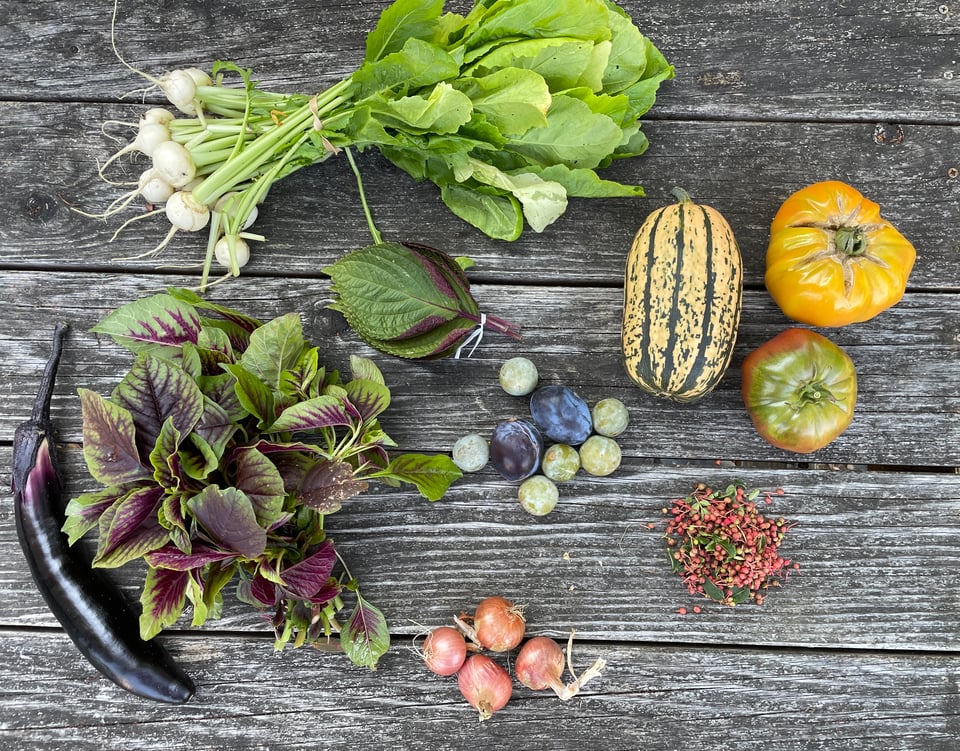CSA Week 15: Peppercorns, Plums, and Planning

Farm Share Newsletter - September 17, 2023

Housekeeping
Thank you to everyone who responded to our October 1 CSA event invite. We've decided to have a harvest-and-ferment activity! Everyone who did RVSP — we have it — and we'll respond in due time.
This Week's Share (L to R, top to bottom):
-Hakurei turnips
-Eggplant
-Amaranth
-Perilla
-Plums (damsons and greengages)
-Delicata squash
-Heirloom tomatoes
-Baby shallots
-Sichuan peppercorns
Oops
Every so often we walk into the fields and notice that our beds look depleted. That happened on Saturday, as we began harvesting for Ballard Farmers Market. Usually, a veggie downturn means we missed a seeding or transplanting or two or five or eleven. I suspect that getting married in the middle of the farming season might have had something to do with our current deficit.
So — to let our baby bok choy and gai lan and komatsuna grow — we've decided to take Wednesday off from market and go hiking! Don't worry, we'll still deliver CSAs that day. Letting our veggies grow also meant we needed to do a little outsourcing.
Some of your plums come from our landlady Amy, who welcomed us the first time we met her with a plum buckle. Her damson plum tree is super prolific, producing enough every year for dozens of buckles. Your greengage plums come from our neighbors, Henna and Wylie, who recently moved up north but still allow us to harvest from their trees. We also grew our garlic on their land this season.
Your baby shallots are not intentionally small. We seeded some last minute in the spring to diversify our alia (onion and garlic family) offerings. That was way too late, and thus, baby shallots. We've tried them as such and they are tasty, but I would recommend letting them cure by a window that gets plenty of sun for a week or two.
Our delicata squash harvest signals the transition from summer to fall. The earliest winter squash, delicata are also one of the only varieties that don't require curing (or peeling!). Delicata are typically roasted, but I included a sautéed recipe below.
All About Your Sichuan Peppercorns
For those that don't know, Sichuan peppercorns are an essential component of the region's cuisine, giving characteristic ma (tingly) component of mala (tingly-spicy). Most Sichuan peppercorns purchased in the U.S. (and probably everywhere) come dried.
The fresh Sichuan peppercorns in your share come from Kurtwood Farms, which also supplied the Asian pears from a couple shares ago. Kurt planted two trees from cuttings ten years ago as part of a big culinary project. When he opened an ice cream shop in Seattle, Kurt used his peppercorns as a flavoring. The trees are huge now, although one of them has some kind of disease that has really dampened to its production. Anyway, if you've never seen a Sichuan peppercorn tree, imagine a tree from the darkest depths of Guillermo Del Toro's imagination, curling and weaving and covered in two-inch-long thorns. By the end of the peppercorn harvest, my arms were covered in scratches. It was worth it though, because, in addition to their signature tingling effect, fresh Sichuan peppercorns have this incomparable citrusy punch that you just don't get from ones that were grown, packed, and shipped over from China over, I don't know, months. If you want to eat them fresh, use them relatively quickly. I'd recommend toasting them in a dry pan first (as you would nuts) to bring out the essential oils, and then just add them whole to your cooking oil or even at the end. I would store them in an open paper bag. Presumably, keeping them in an airtight container should prolong their shelf life, but we have found that they just begin to mold after a while. The problem is that in an open paper bag, they'll dry out in about a week. When they dry, the husks will pop open, revealing the seed. You can discard the seed, and the husks will stay good for about a year, after which they'll begin to lose their potency. The citrusy element will also begin to fade, so I would recommend using them earlier rather than later.
Recipe: Sautéed Delicata Squash

When I want to eat delicata squash but don't feel like waiting for our oven to pre-heat, I'll sauté them. Pictured above is delicata with furikake, but you could try whatever spice you'd like.
Ingredients:
One delicata squash
2 tbsp olive oil
1 tsp sugar
Furikake, grated parmesan, or other topping (optional)
Steps:
Cut your delicata in half, the long way. Scoop out seeds with a spoon (these can be roasted like pumpkin seeds if you'd like or discard). Slice into inch-thick moons.
Heat olive oil over medium heat. Add delicata moons in a single layer. Saute until browned on one side. Flip delicata. Saute until fork-tender (10-12 minutes).
Add sugar and stir to incorporate. (About 1 minute).
Serve delicata on a plate and add your topping.
'Til Next Week,
Steven
